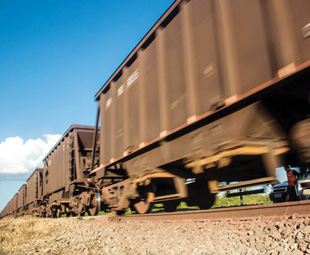Rail set to save the day in Brazil

Cargo thefts cost Brazil around R2,6 billion in 2016 and have left transporters exasperated. However, the country hopes to turn its infrastructure crisis around by investing heavily in rail. MARISKA MORRIS reports
Infrastructure remains a challenge for developing countries with Brazil, Russia, India, China and South Africa (BRICS countries) being no strangers to its woes. This is particularly true for Brazil.
Reuters reports that Brazil spends only 2,5 percent of its gross domestic product (GDP) on infrastructure – a third of that spent by China and less than half of that spent by South Africa and Russia. The lack of infrastructure in Brazil costs its economy around 151-billion reais (R640 billion) annually.
The infrastructure shortcomings are particularly visible in the country’s railway system. This has forced many companies to transport cargo by truck, which is slower, more expensive and very dangerous, especially when travelling through Rio de Janeiro.
A special correspondent for Journal of Commerce in Brazil, Rob Ward, reported on a spike in cargo thefts in Rio de Janeiro in August. He noted that, while cargo theft is a countrywide problem, it is especially problematic in the two largest cities of Brazil – Rio de Janeiro and Sao Paulo. These two cities account for 88 percent of all cargo theft.
Rio de Janeiro had the most cargo thefts in 2016. There was a 22-percent increase in thefts in the city during 2017 with 22 500 cargo thefts in total. Non-profit organisation Firjan – which promotes business competitiveness and is situated in Rio de Janeiro – reportedly said that 619-million reais (R2,62 billion) was lost in 2016 due to cargo theft.
The country’s recession, together with the fact that the Federal Highway Police is understaffed, has reportedly aggravated the cargo thefts – the worst the country has seen. Despite a considerable increase in the amount of cargo travelling in the country, there are only around 10 000 police officers, which is around 3 000 fewer than the agency needs.
According to Ward’s article, the gangs in Brazil are now targeting smaller, lower-value shipments. These stolen shipments are rarely recovered, as the police do not enter many of the worst favelas (slums) in Brazil.
 To manage the spike in cargo theft, the government of Brazil deployed troops in Rio de Janeiro. Roadblocks have been stepped up by the military at the four notorious favelas to prevent hijacked trucks from entering the slums.
To manage the spike in cargo theft, the government of Brazil deployed troops in Rio de Janeiro. Roadblocks have been stepped up by the military at the four notorious favelas to prevent hijacked trucks from entering the slums.
The lack of infrastructure will hopefully not be a crisis for much longer as Brazil introduces its new infrastructure investment plan – Advance. The programme aims to inject US$ 16 billion (R211 billion) into various sectors between 2017 and 2018.
Port Strategy reports that 50 projects were put forward by the Ministry of Transport to be part of the programme, which included the completion of the North-South Railway (FNS) which is planned to run from Belém in northern Brazil to the most southern city in Brazil, Rio Grande.
Around 1 575 km of the railway has been completed with authorities struggling to complete the northern section of the FNS from Açailândia to Barcarena (around 494 km). In the meantime, the state of Pará in northern Brazil is putting its planned 1 316 km Paraense Railway (Fepasa) into action.
This railway is planned to run parallel and to the west of the FNS. It will connect Santana do Araguaia with the port of Vila do Conde in Barcarena. The International Railway Journal (IRJ) reports that the Brazilian government wants to merge the FNS with the Fepasa, instead of completing the northern section, by simply extending the line from Rondon do Pará to Açailândia by 58 km. Companies using the FNS will thus have access to a port in Pará for exporting goods.
Fepasa and the expansion of the port is estimated to cost around 14-billion reais (R59 billion) and will have the capacity to carry up to 170-million tonnes of freight annually. The viability of Fepasa is already visible with two companies committing to using it as a mode of transport.
IRJ quotes the Minister for Economic Development, Mining and Energy, Adnan Demachki, as saying: “Vale, Brazil’s largest mining company, will participate in the project and will use the line for its freight, although the volumes involved are still under study by the company. In addition, the Norwegian company Norsk Hydro will sign a commitment to transport approximately five-million tonnes per year.”
 Brazil has also proposed a Bi-Oceanic Centrail (CFBC) transcontinental railway linking Brazil and Peru. The estimated cost of this 4 900-km railway is around 30-billion reais (R127 billion). However, there are still debates surrounding the route of the railway.
Brazil has also proposed a Bi-Oceanic Centrail (CFBC) transcontinental railway linking Brazil and Peru. The estimated cost of this 4 900-km railway is around 30-billion reais (R127 billion). However, there are still debates surrounding the route of the railway.
IRJ reported that Peru wants the railway to pass through the Andean region. It was, however, planned to start in Campinorte, Brazil, and travel to the Peruvian border where it would turn south to reach Porto Ilo on the Pacific Coast. Adopting the new route would cost the government of Brazil an additional 20-billion reais (R84 billion).
In addition to this, IRJ reports that the track gauges in the two countries differ. Brazil wants to use a 1 600-mm gauge on the new railway, while Peru still uses a standard
1 435-mm gauge, which is used by 55 percent of railways around the world.
It would not be the first instance in which very ambitious projects were left incomplete. In 1999, plans for the
1 753-km Transnordestina railway began. The project was halted earlier this year after almost two decades and 11,2-billion reais (R47 billion).
Whether Brazil’s heavy investment will pay off remains uncertain, while transport and logistics companies operating in Brazil continue to struggle with poor infrastructure and cargo theft. Troops deployed in Rio de Janeiro are set to remain in the city until December.
Published by
Focus on Transport
focusmagsa



